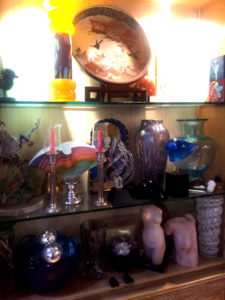 JR sent me a photo of a cabinet filled with objects. How does she determine the value of that art?
JR sent me a photo of a cabinet filled with objects. How does she determine the value of that art?
She asked, “since I have time at home, how do I determine what objects to save, what to donate (when I can), and what to insure? I also own some art I’ve wondered about for years. What are the best research sites for valuation?”
What a great question for those of us who put this kind of research on the back burner for years. I can HELP.
Here’s some of my favorite sites for researching certain types of objects. You’ll need a subscription, which can cost $500 plus for a year, but some sites offer short-term subscription rates. Many sites now give promotions, or reductions, due to the crisis. I suggest that if you love one of these sites mentioned, email and ask for a discount on a year’s rate.
prices4antiques.com
For porcelain, glass, lamps, clocks, textiles, and decorative art (as opposed to fine art) from antique to modern, go to prices4antiques.com. To try them out, get a 15-day unlimited searches trial at about $30. JR, p4a.com uses photos as search tools if you lack the words to describe an object.
JR’s cabinet contains Murano glass, which with a certain design and signature, is worth more than unsigned, production-grade pieces. p4a.com shows similar pieces and signature photos as well.
I see a Boehm porcelain figure of a blue jay. P4a.com reports the value of that piece, as well as the date of the sale when it achieved that price. However these figures are devalued in the market today, so you might want to sell NOW. If so, p4a.com publishes the auction house that sold that piece like yours, and that house is a good choice for selling yours.
The Value of Your Art, JR? Three sites for you:
ArtPrice’s year subscription runs $250, but they cover 6,300 auction houses and sales since 1962. I mention this because this is a great way to research the historical values PAID for the work of a given artist over the years. If you see the curve of sales over time going down, you may want to sell. And you’ll know the auctions that sold that artist in the past. Artprice.com also includes a running series of photos of each piece sold. If you subscribe you have unlimited searches. ArtPrice does NOT offer a short-term subscription but is the least expensive comprehensive site for a year term, with unlimited searches.
The best but most expensive site for researching art is ArtNet.com, but you can get a one-day pass for five searches for about $30. If five searches aren’t enough, buy ten searches for a little more. A yearly subscription costs $450. This site includes not only auction houses, but smaller sales platforms, but a subscription price includes only limited searches.
If you want to insure a work of art, either site above will help establish fair market value, but you should insure your pieces for MORE than they might sell for at auction. The theory is: what you can sell something for (price) is not the same cost at a gallery.
JR, you ask what art you should KEEP for your children, and the determinate for this is today’s VALUE and the probability of INCREASE in value. Historical prices paid at auction sales are the best indication of future value. Both ArtNet.com and ArtPrice.com show sales over time for a certain artist. This is most helpful when you have a print, for example, in a certain edition size (edition equals how many were made). See if the value has increased by charting the same image over time.
JR owns a series of American lithos by Grant Wood. The best site for American art is AskArt.com, and they include non-oil media, such as photos, lithos, woodcuts. You get ten searches for around $20 a day. I procured a monthly roll over subscription at $30 a month. Photos of art on this site are the finest, and largest, so you really see comparisons with quality. These great photos are helpful if you have trouble making out a signature on a work of art, which is a big problem when using any research site. AskArt.com and ArtPrice.com offers you options for artist’s names similar to the spelling you type in the search engine.
Now that you have time, JR, discover what’s on your OWN walls.
Pingback: Inspection Guide for Remote Appraising - Elizabeth Appraisals